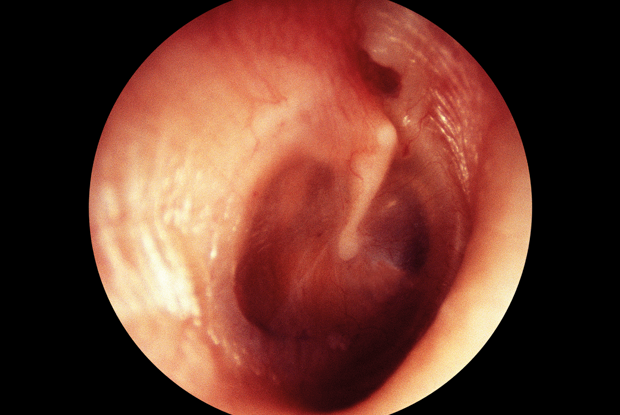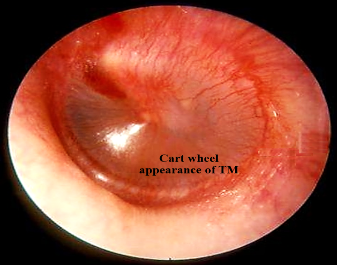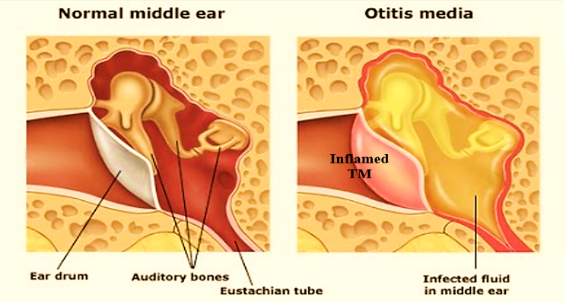
ACUTE OTITIS MEDIA
Definition: It is an Acute infection affecting the mucosal lining of the middle ear cleft and the mastoid air-cell system.
It often follows an upper respiratory tract infection.
Acute otitis Incidence
ASOM is usually seen in infants and children of low socioeconomic status.
Causative Organisms:
- Beta hemolytic streptococci and streptococcus pneumonia.
- Haemophilus influenzae.
- Staphylococcus aureus.
- Moraxella Catarrhalis.
- Via eustachian tube: This tube is shorter and wider in children. Infection easily passes into the middle ear via this tube after a bout of tonsillitis, sinusitis or even swimming in unhygienic water.
- Via external ear when there is a traumatic perforation of tympanic membrane- during bathing, swimming, and ear wash.
- Blood borne route is extremely rare.
- Allergy: Allergic edema of the eustachian tube is said to cause occasional acute otitis media.
- Stage of Eustachian tube obstruction: It occurs due to edema and congestion of the mucosal lining of the Eustachian tube leading to negative pressure inside the middle ear leading to mild retraction of the tympanic membrane.
- Stage of Exudation: Middle ear mucosa becomes edematous and congested, resulting in serous exudation inside the middle ear cavity.
- Stage of Suppuration: There is accumulation of purulent and mucopurulent secretions inside the middle ear, this causes bulging of tympanic membrane. The tympanic membrane ultimately ruptures leading to perforation of the drum.

4. Stage of Resolution: The condition is self-limiting in most of the cases depending on the virulence of the organism, immunity of the patient and the effect of medicines. The tympanic membrane starts healing and the hearing gradually improves.
5. Stage of Complication: When the infection spreads beyond the middle ear cleft, it may cause mastoiditis, subperiosteal abscess, facial paralysis, labyrinthitis, petrositis, extradural abscess, subdural abscess, meningitis or brain abscess.
Acute Otitis media Clinical Picture
- Stage of Eustachian tube obstruction: Symptoms: Mild deafness (autophony). Signs: mild drum retraction and mild conducive hearing loss.
- Stage of Catarrhal otitis media: Symptoms: Pain, deafness, tinnitus and mild fever. Signs: Congested tympanic membrane (Cart wheel appearance) with mild to moderate conductive hearing loss.

3. Stage of suppuration:
a. Before perforation:
Symptoms: Severe ear pain, fever, deafness and tinnitus.
Signs: Bulging tympanic membrane which is severely congested with a pale center. Moderate conductive hearing loss.

b. Post Perforation:
Symptoms: Pain disappears and fever drops down, mucopurulent and purulent discharge comes out. Mild deafness and tinnitus present.
Signs: Discharge in the external ear canal, mucoid or mucopurulent and tympanic membrane perforation. Mild conductive deafness.
4. Stage of Resolution: Resolution gradually occurs with subsidence of symptoms and signs. Resolution may be complete or incomplete.
Treatment:
Medical: Local treatment includes ear toilet, antibiotics, steroid ear drops, antihistaminic. nasal decongestants. Systemic includes antibiotics mostly combination of amoxicillin and clavulanic acid, nasal decongestants, analgesics. Steroids may be given in special cases. Surgical: Myringotomy in case there is severe earache with bulging ear drum.
Medical: Local treatment includes ear toilet, antibiotics, steroid ear drops, antihistaminic. nasal decongestants. Systemic includes antibiotics mostly combination of amoxicillin and clavulanic acid, nasal decongestants, analgesics. Steroids may be given in special cases. Surgical: Myringotomy in case there is severe earache with bulging ear drum.

We Are Always Ready to Help You.
Book An Appointment

